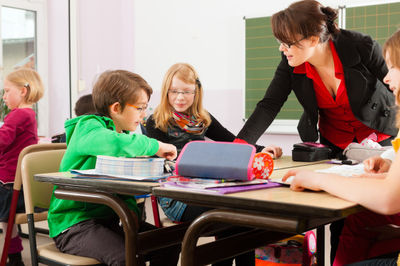Principles of Teacher-Student Communication for Classroom Trust

When presented with the dilemma to name the most important element of education, one has many options. A music teacher would comment that a student's willingness to express himself/herself rhythmically takes precedence over anything else-the role of the teacher is not heavily emphasized. An advanced math teacher would say that the students' motivation for learning the subject holds extreme importance. A kindergarten teacher might answer that keeping the students' interest is paramount. All of these scenarios are true.
Table of Contents
Do you want to teach English abroad? Take a TEFL course!
This post was written by our TEFL certification graduate Jamie B. Please note that this blog post might not necessarily represent the beliefs or opinions of ITTT.
What is Rapport?
While we can agree that allowing a student to be expressive, knowing the student's motivation, and keeping the students' interest are important aspects of education, the rapport that is established between a teacher and student is of utmost significance. To fully understand this importance, we must first explore what rapport truly is. Once that is accomplished, we can examine two of the various ways in which student/teacher rapport is used: rapport can be used as a means for establishing trust, and rapport can be used as an indicator or success.
Rapport is a close and harmonious relationship in which every person involved comprehends each other's feelings and ideas-creating room for close communication and a greater sense of empathy. While anyone looking to establish any type of mutually beneficial relationship should have an intrinsic method for doing this, there are multiple resources available that give examples of how establishing and maintaining rapport is easily accomplished. A quick internet search gives tips such as making good first impressions (greeting everyone with warmth, sincerity, and a willingness to connect on a personal level), developing empathy, maintaining positive eye and body language, etc., as ways in which rapport can be initiated. Once the relationship between student and teacher is established, then we can look at a couple of ways in which it is used to gain trust and indicate success.

Also Read: Do TEFL certificates expire?
How to Work on it?
Establishing rapport is the foundation for gaining trust. Imagine the trepidation a student feels upon entering a classroom for the first time. Most students are a bit excited, but also anxious and reserved; they don't know what to expect. They would usually look for cues that represent safety and warmth. A warm smile from the teacher goes a long way in allaying the rush of emotions that the learners feel when entering the classroom. Scientifically speaking, the neurotransmitters that play in role in expressing happiness (serotonin, dopamine, and endorphins) are released when we smile. Smiling has a way of disarming people. It is the first non-verbal cue that students should see, and it allows for the commencement of the student/teacher relationship that will mature as time passes. It is a simple step, but an important step nonetheless; it is the cornerstone of establishing trust.
In the education field, rapport is also used as an indicator of success. To find this, one simply has to scrutinize past progress reports, test scores, measurements of student language acquisition, etc. From these resources, we could make generalizations about the general emotional wellbeing of students. Students with high test scores, high self-esteem, and an all-around good feeling of accomplishment usually report that their behavior and relationship with the instructor as satisfactory. Since this is true, it could be safe to assume that generally low scores, little to no feelings of improvement, and a lack of respect between the student and the teacher correlate with bad rapport.
Also Read: English as a Foreign Language in Kindergarten
In retrospect, I can reassess the courses that I did not do so well in, and remember my feelings toward the instructor. While I can claim responsibility for my shortcomings, I do not have the fondest memories of the classes that I did not do so well in. I remember my favorite teachers as opposed to my horrible classes! Due to a few good teachers, I ended up liking and excelling in subjects that I thought I would hate! I owe part of my success in university to instructors who wanted to build a relationship with me, and instructors who strove to make the lessons enjoyable. My successes are very much intertwined with the relationships that I forged with my instructors.
Do you want to teach English abroad? Take a TEFL course!
In summation, the rapport between a student and teacher is fundamental. It is, without a doubt, imperative in the learning process for the student. We use rapport to gain the learner's trust. Without trust, there is simply no relationship. Also, we use rapport as a measure of success. Good teacher/student rapport usually produces good results and a general feeling of accomplishment for everyone. With the knowledge that rapport acts as a unifying factor with student behavior, motivation, and emotional wellbeing, we can safely educate our learners, knowing that our relationship with them will have a defining impact on their future educational objectives and achievements.
Apply now & get certified to teach english abroad!
Speak with an ITTT advisor today to put together your personal plan for teaching English abroad.
Send us an email or call us toll-free at 1-800-490-0531 to speak with an ITTT advisor today.
Related Articles:
- Where to Earn the Highest Salaries Teaching English Abroad
- How to Save Money While Teaching English Abroad?
- 10 Questions You Need to Ask Before Enrolling In a TEFL Course
- What It's Like To Teach English Online: An Online Teacher Reveals Her Secrets!
- All the Documents You Will Need to Teach English Abroad
- Getting Student Placement Right - The Best Desk Arrangements for EFL Students



